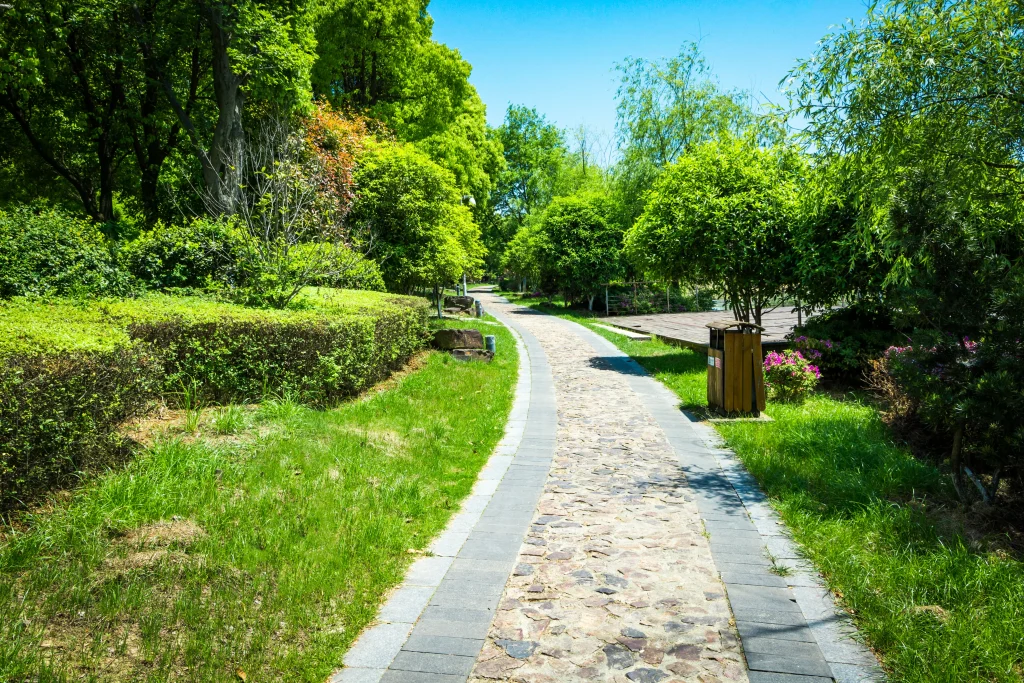The Mile High City’s clay-heavy soil, intense UV exposure, and temperature swings demand smart gardening solutions. Raised flower beds offer the perfect answer to these conditions.
These elevated gardens provide superior drainage compared to ground-level planting. Clay soil, common throughout the Denver metro area, retains water and compacts easily. Raised beds eliminate these problems while warming up faster in the spring. The elevated design creates better air circulation around plants and reduces soil compaction from foot traffic.
This guide presents over 19 beginner-friendly raised flower bed ideas and practical installation tips. Whether you garden on a compact patio or sprawling backyard, these raised bed flower garden ideas will transform your outdoor space into a thriving garden oasis.
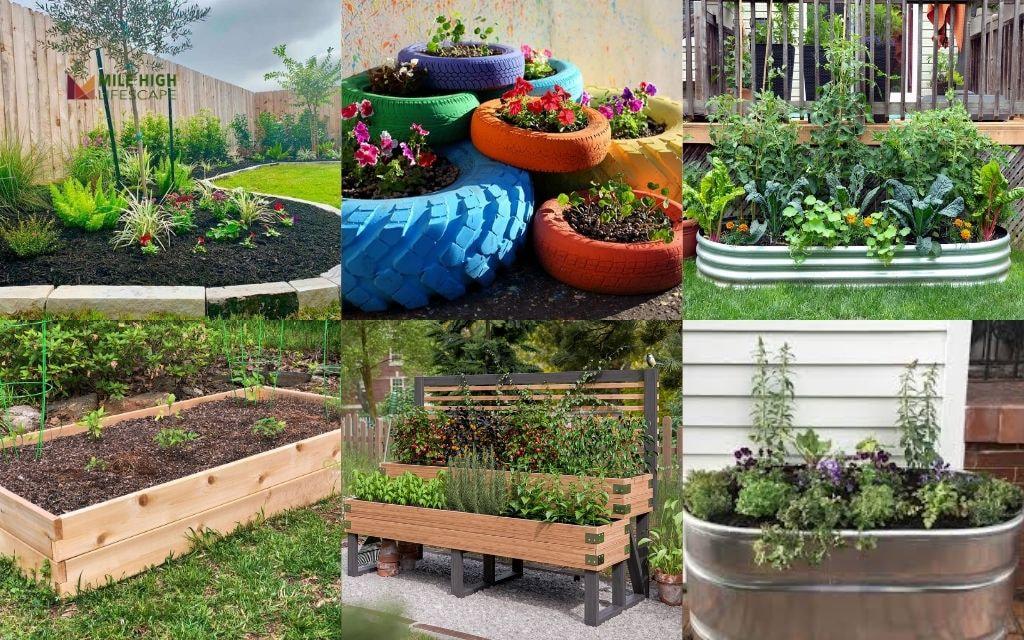
19+ Raised Flower Bed Ideas for Every Style and Yard Size
Rectangular Wooden Raised Bed
After years of battling Colorado’s challenging soil, you’ll appreciate the simplicity of a classic rectangular design. These timeless raised flower beds ideas use cedar or pine lumber to create clean lines that complement any landscape style.
Fill them with native perennials like penstemon, blanketflower, and black-eyed Susan for low-maintenance color. The straight edges make mowing easier while the native plants thrive in Denver’s dry conditions without constant watering.
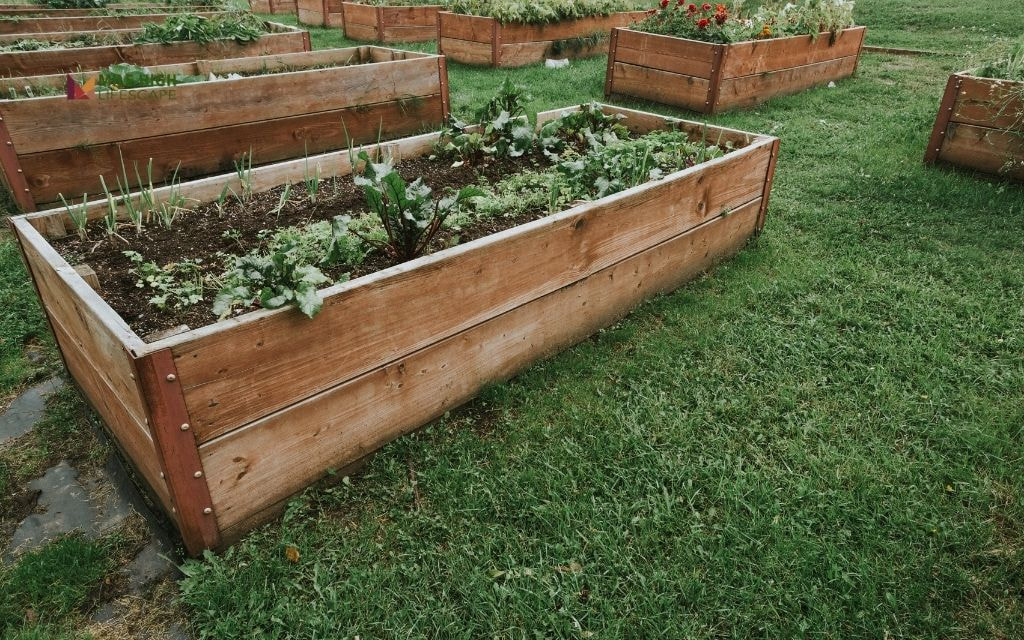
Brick-Lined Flower Bed Bordering a Porch or Walkway
Transform the space along your walkway into an elegant garden feature with brick-rimmed raised beds. These structured designs create clear boundaries between hardscape and planting areas while adding architectural interest to your property. Plant with coral bells, columbine, and low-growing sedums for year-round appeal that handles Denver’s intense sun and occasional late freezes.
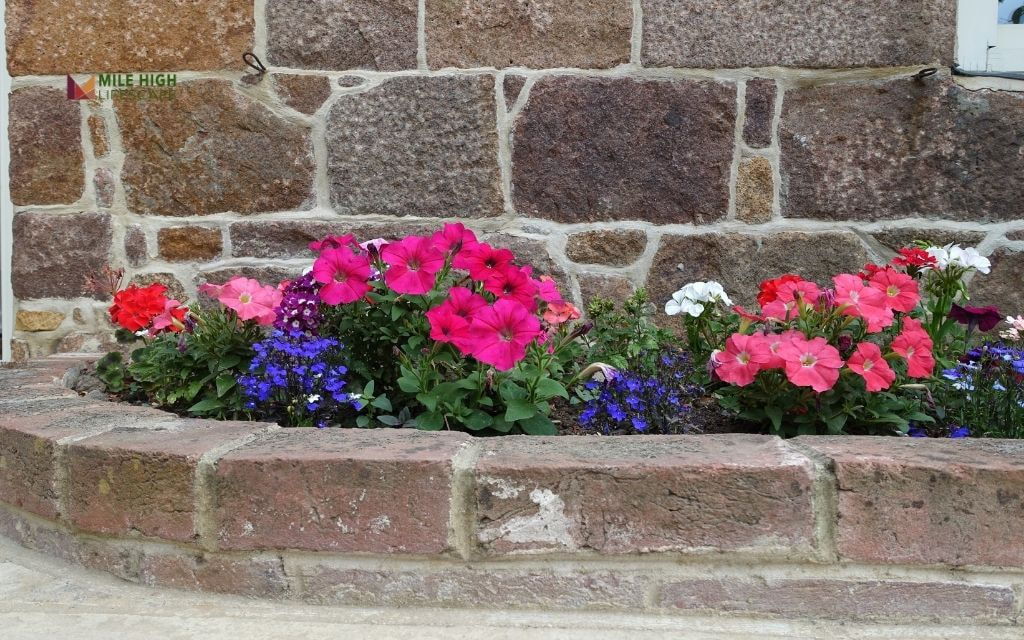
Cedar Raised Beds
Maximize your growing space by adding vertical elements to traditional raised bed designs. Cedar lumber resists Colorado’s dry climate while the trellis backdrop supports climbing plants and creates privacy screening.
This combination works perfectly for narrow side yards or areas where you want to block unwanted views. Train clematis, honeysuckle, or even annual climbing nasturtiums up the trellis while filling the bed below with complementary flowers that bloom at different times.
Tiered Raised Flower Bed
Denver’s foothills and many residential areas feature sloped terrain that challenges traditional gardening approaches. Tiered raised beds transform these slopes into functional planting areas while preventing erosion.
Each level catches rainwater and snowmelt, creating natural irrigation for the tier below. Plant drought-tolerant varieties on upper levels and moisture-loving species in lower sections. This creates diverse microclimates within a single design.

Square Bed with Mixed Annuals
Square raised beds offer perfect proportions for seasonal displays that change with Colorado’s distinct growing seasons. Their compact design makes plant rotation simple while providing enough space for impactful color combinations.
Spring brings pansies and primrose, summer showcases marigolds and zinnias, while fall displays mums and ornamental kale. The contained space makes soil amendment easy when switching seasonal plantings.
If you want more amazing flower bed inspiration, check out this blog.
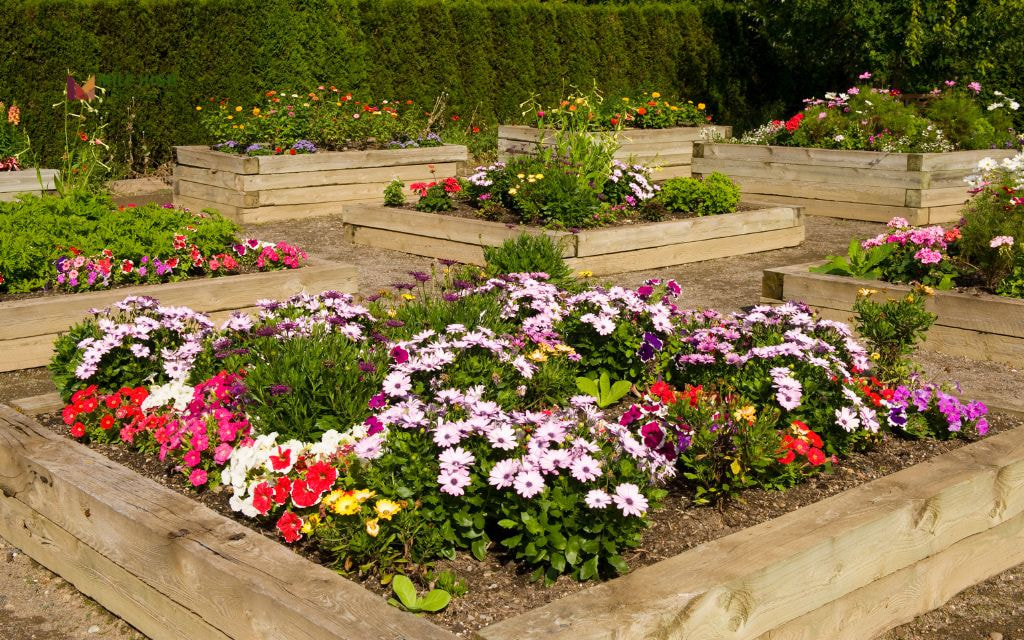
Mini Raised Beds with Handles for Balconies and Patios
Apartment dwellers and condo owners need not abandon their gardening dreams.
Portable mini raised beds bring flower power to the smallest spaces while remaining light enough to move with changing sun patterns or weather conditions.
These compact gardens work perfectly on balconies, patios, or deck areas where permanent installation isn’t possible. Fill them with herbs, small flowers, or compact vegetables that thrive in containers.
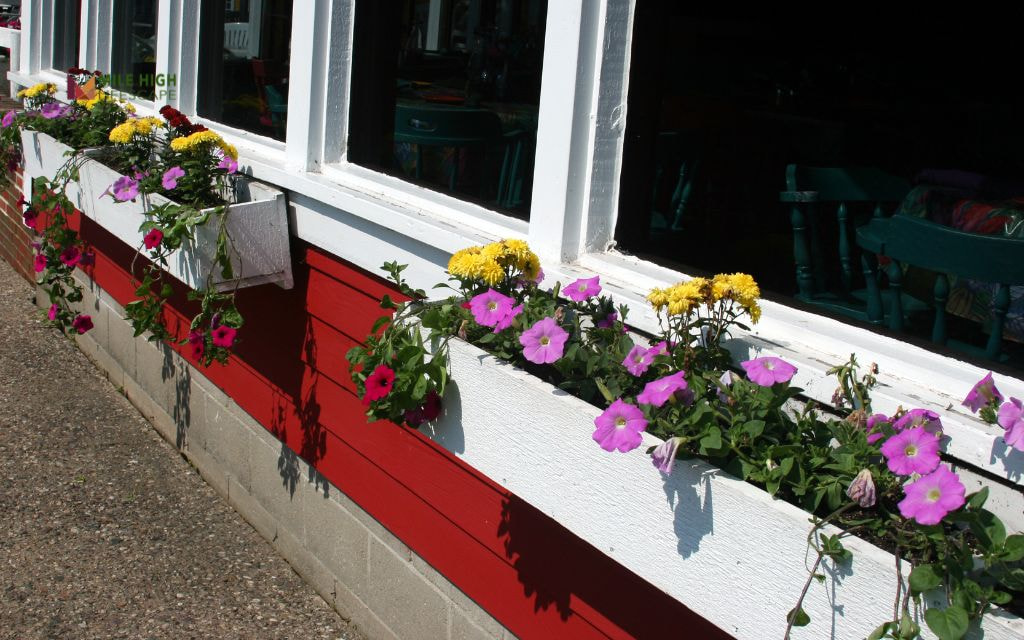
Trough-Style Metal Raised Beds
Galvanized steel troughs create sleek, modern raised flower beds ideas that fit perfectly in narrow side yards or against fences. The metal material reflects Denver’s abundant sunshine while the linear design maximizes planting space in tight areas.
These beds warm quickly in spring and drain efficiently during Colorado’s intense summer thunderstorms. Plant with ornamental grasses, sedums, and other architectural plants that complement the industrial aesthetic.
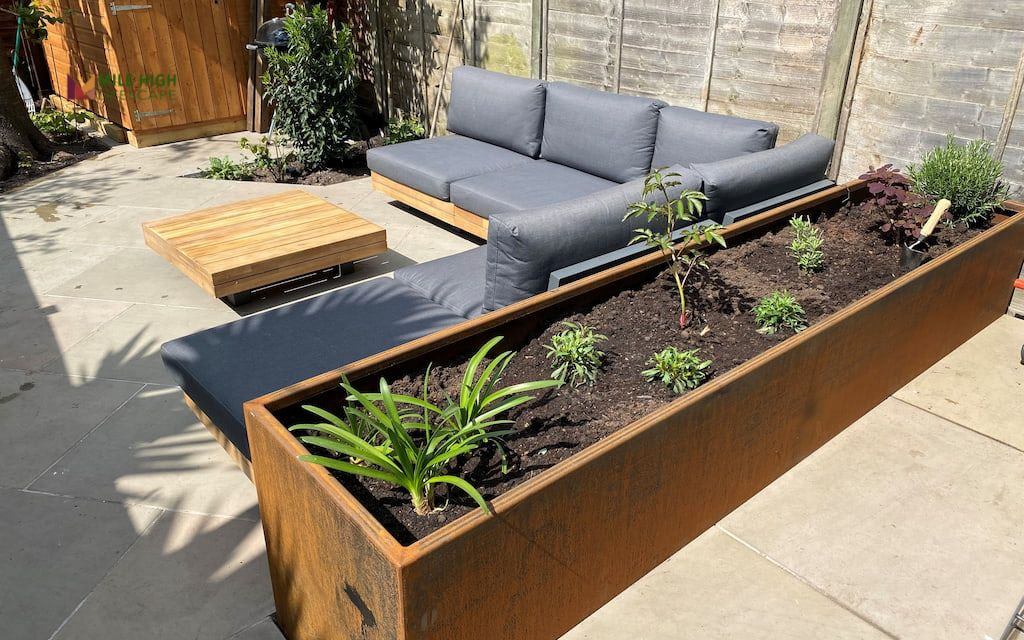
Corner-Layered Raised Beds for Tight Side Yards
Transform forgotten corner spaces into garden focal points with custom-angled raised beds. These triangular or curved designs fit into areas where rectangular beds won’t work.
The layered approach creates visual interest while providing different growing zones within a small footprint. Use these spaces for specialty plants like native wildflowers or rock garden specimens that showcase Colorado’s natural beauty.
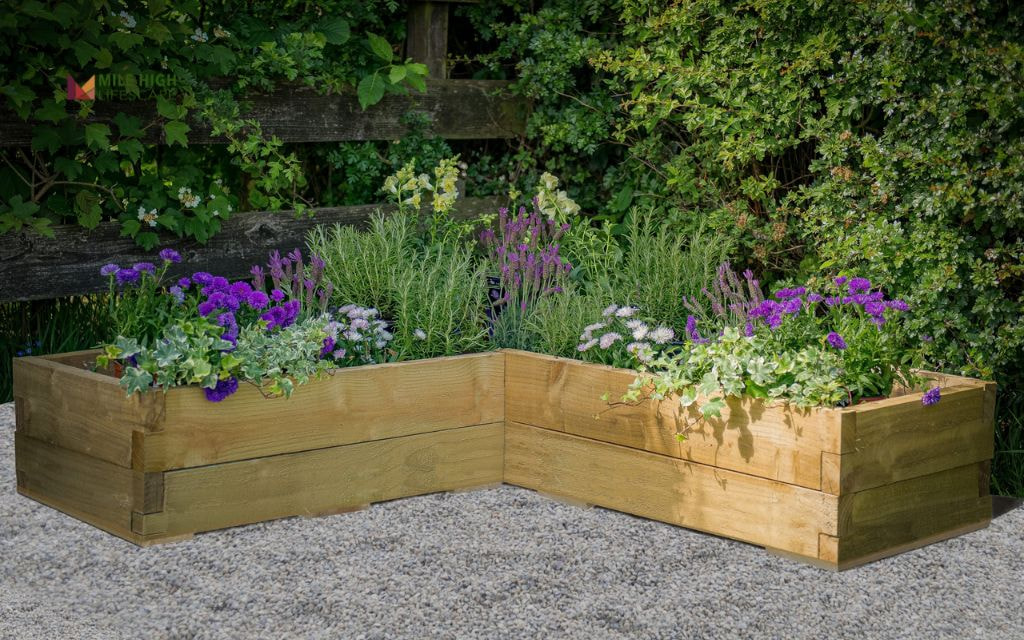
Hanging Wall-Mounted Flower Beds
Vertical gardening maximizes limited space while creating living walls that provide privacy and beauty.
Wall-mounted planters work particularly well on south or west-facing fences where they receive abundant Colorado sunshine. The elevated position improves drainage while protecting plants from ground-dwelling pests.
Fill these flower garden ideas with trailing plants like petunias, lobelia, or cascading sedums that create waterfall effects.
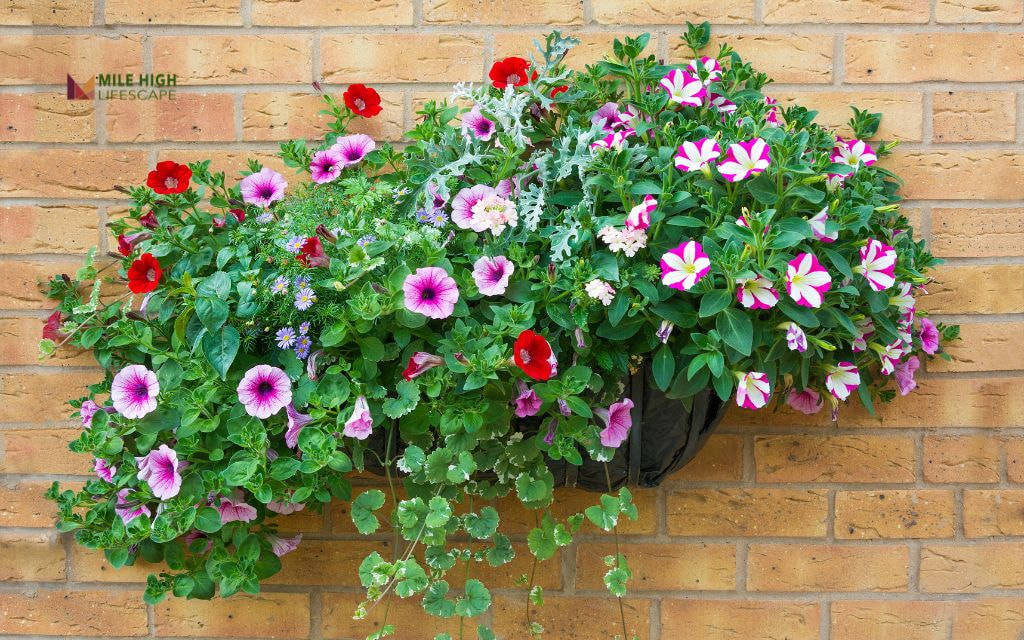
Reclaimed Crates or Boxes Turned into Flower Beds
Sustainability meets style when you repurpose wooden crates, old dresser drawers, or shipping boxes into unique raised flower beds. This approach reduces waste while creating one-of-a-kind garden features that reflect your personality.
Line containers with landscape fabric to prevent soil loss while maintaining drainage. These temporary beds work perfectly for renters or anyone wanting to experiment with different layouts before committing to permanent installations.
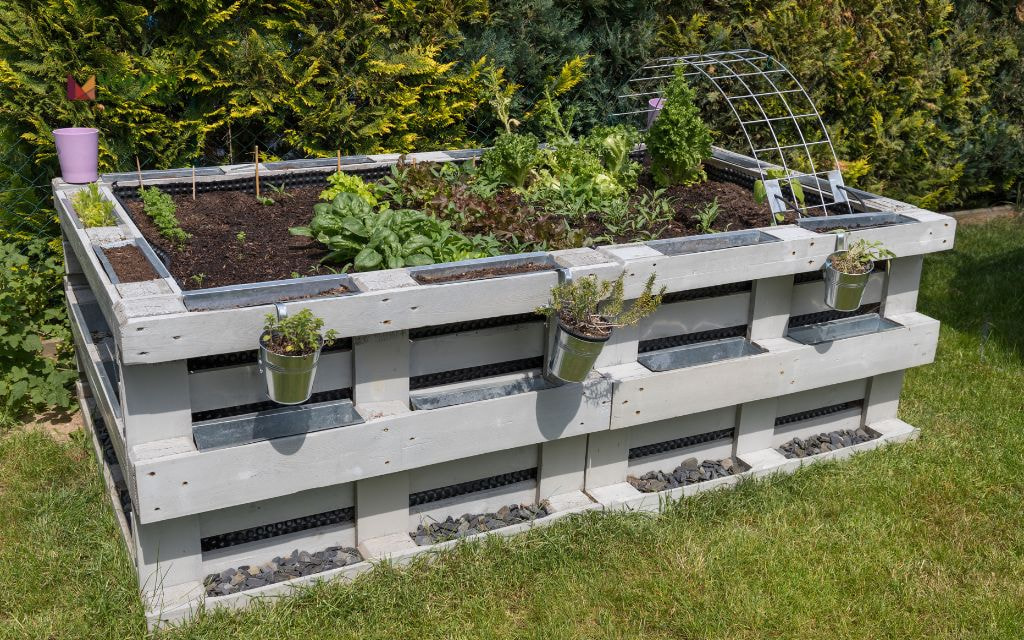
Dry-Stacked Stone Flower Bed with Native Grasses
These chemical-free constructions require no mortar while providing excellent drainage and thermal regulation. The natural stone complements Denver’s mountain views and architectural styles common throughout the metro area. Fill these beds with native bunch grasses like buffalo grass, blue grama, or ornamental varieties that move gracefully in Colorado’s frequent winds.
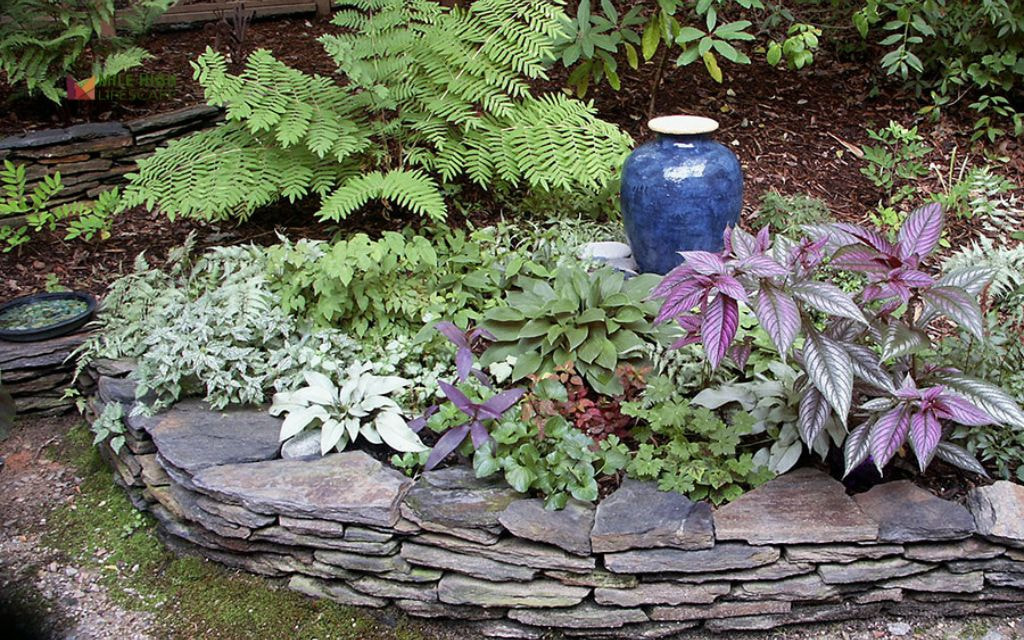
Circular Lava Rock Raised Bed
Lava rock’s porous nature and dark color create ideal conditions for heat-loving plants while providing excellent drainage. The circular design creates a natural focal point in any landscape while the rough texture contrasts beautifully with soft flower forms.
Plant with bee balm, coneflower, and native milkweed to support Colorado’s declining pollinator populations. The thermal mass stores heat during cool nights, extending the growing season. Discover more great lava rock landscaping designs in this article.
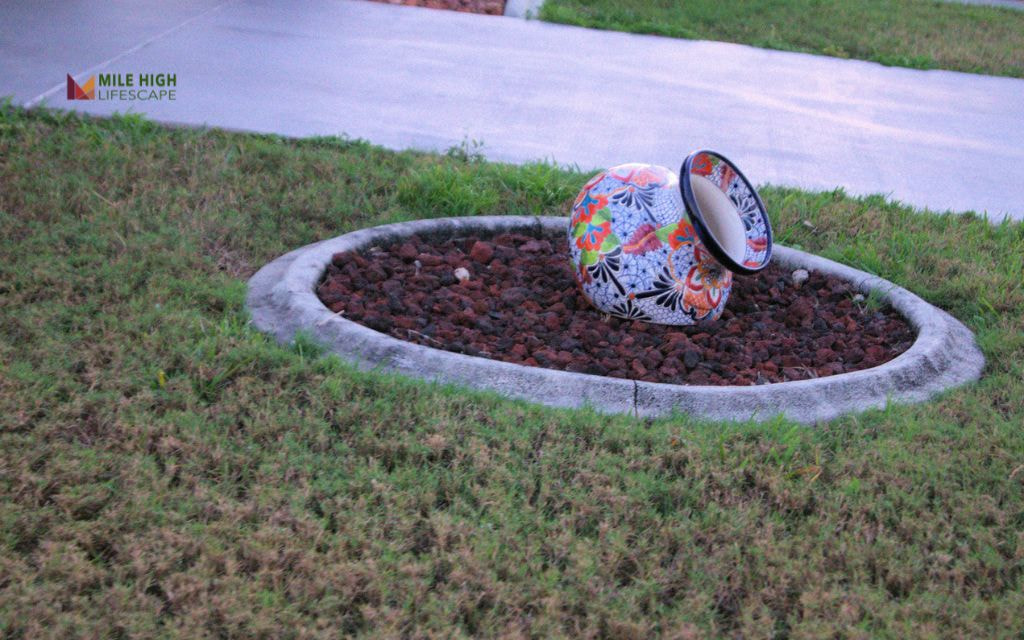
Flagstone-Rimmed Flower Bed with Mulch Interior
Flagstone’s flat surfaces create clean, professional edges while the natural stone colors complement Colorado’s landscape palette. These raised flower beds ideas work particularly well near patios or walkways where the stone ties into existing hardscape elements.
The interior mulch suppresses weeds while conserving moisture, crucial considerations in Denver’s arid climate. Plant with drought-tolerant perennials that require minimal supplemental watering once established.
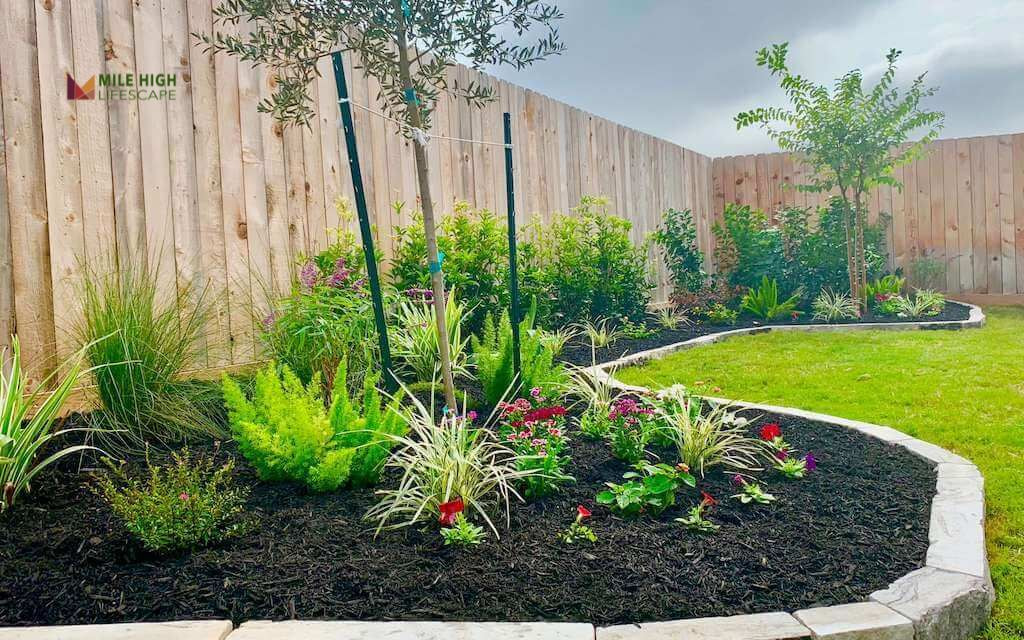
Retaining Wall Turned into Raised Bed for Sloped Yards
Many Denver properties feature slopes that require retaining walls for erosion control.
Transform these functional structures into beautiful raised flower beds by creating planting pockets along the top. This dual-purpose approach maximizes space while solving multiple landscape challenges simultaneously.
The elevated position provides excellent drainage while the retained soil below stores moisture for plant roots.
Dive deeper into 40+ inspiring retaining wall solutions for your yard.
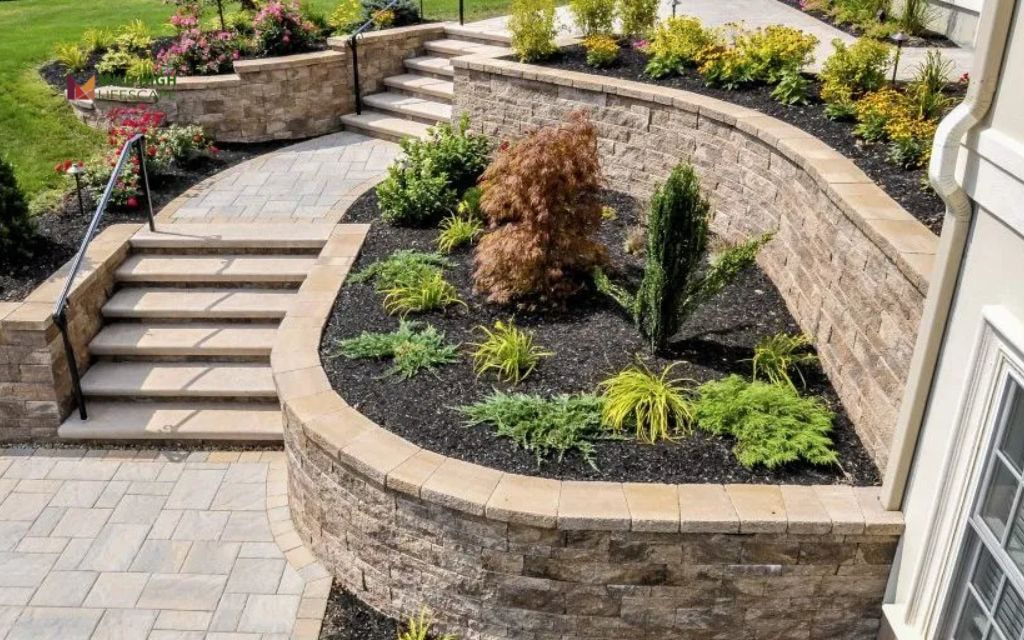
Pallet Wood Raised Flower Bed
Reclaimed shipping pallets offer free or low-cost materials for creative raised bed construction. The pre-made slat design provides natural drainage while the rustic appearance fits perfectly with cottage garden styles.
Sand rough edges and treat with food-safe sealers to extend lifespan in Colorado’s intense UV conditions. These temporary structures work well for annual displays or experimental garden layouts.
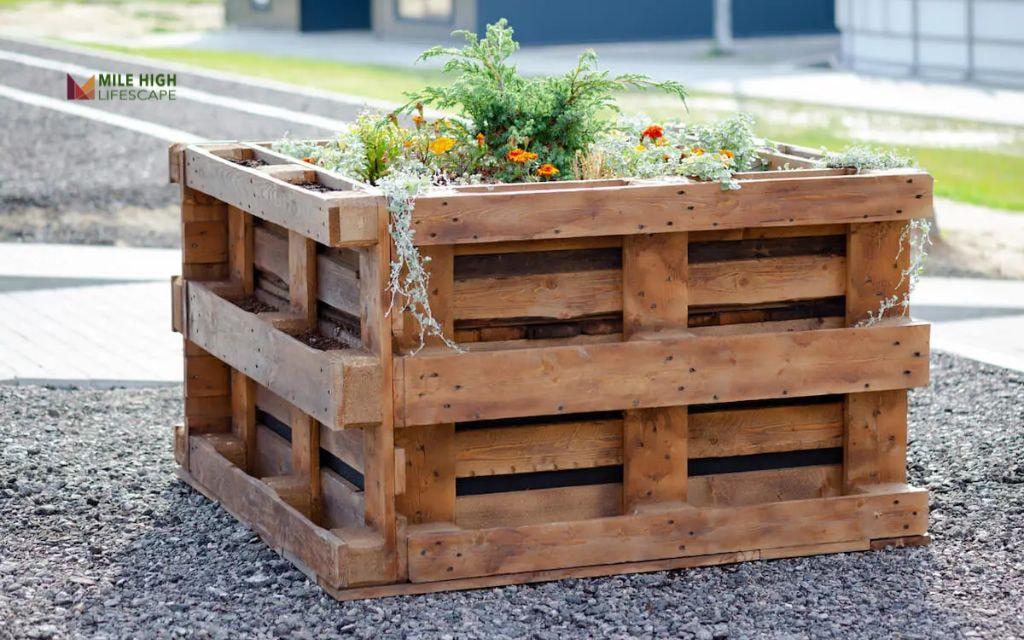
Concrete Block Raised Bed with Inset Herb Pockets
Standard concrete blocks create sturdy, long-lasting raised beds while their hollow cores provide perfect planting pockets for herbs or small flowers. This design combines vegetables or larger flowers in the main bed with complementary herbs or trailing plants in the block openings.
The thermal mass helps moderate soil temperature while the modular design allows easy expansion or reconfiguration as garden needs change.
Repurposed Galvanized Tubs as Flower Containers
Old watering troughs, wash tubs, or large galvanized containers create instant raised beds with vintage charm. The metal construction handles Colorado weather extremes while the pre-made drainage makes installation simple.
These portable options work perfectly for renters or gardeners who want flexibility in garden layout. Group multiple containers of different sizes to create dynamic displays that change with the seasons.
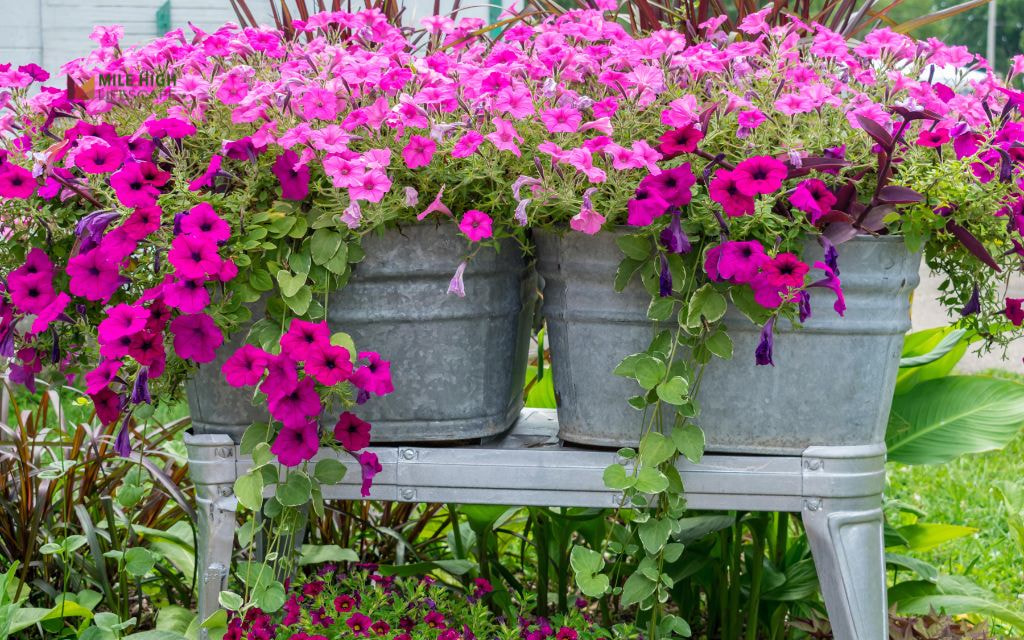
Raised Bed with Built-in Seating and Flower Edges
Combine functionality with beauty by incorporating seating areas into raised bed designs. Wide edges provide comfortable spots to rest while tending gardens or simply enjoying outdoor spaces. Use weather-resistant materials like cedar or composite lumber that handle temperature extremes and intense UV exposure.
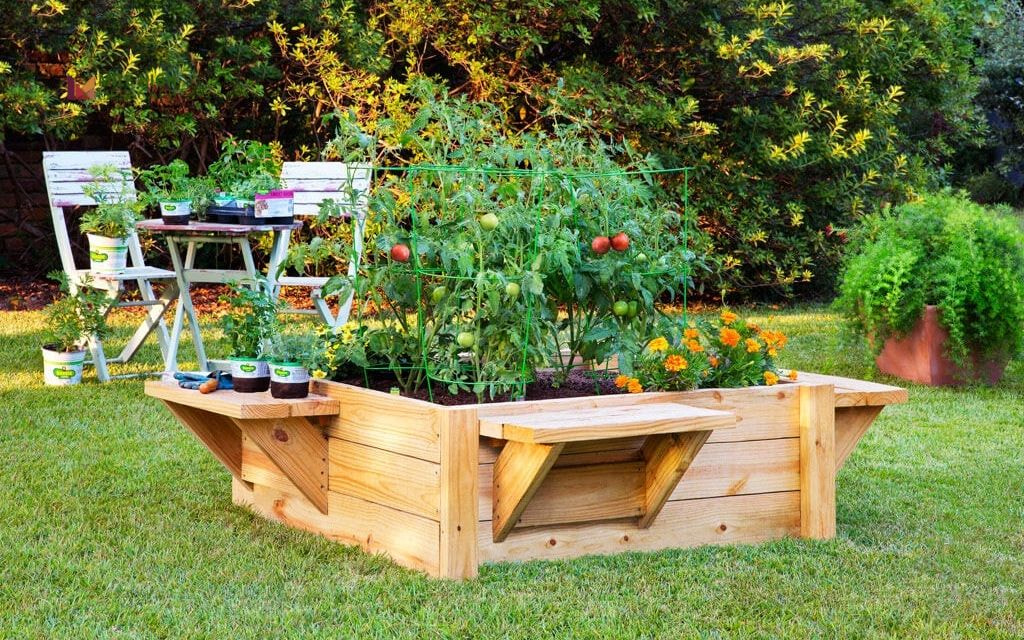
Living Wall Raised Bed with Flowers + Edibles Mixed
Vertical growing systems maximize production in minimal space while creating stunning visual displays. These ideas for raised flower beds combine ornamental flowers with edible plants for gardens that feed both body and soul.
The vertical design improves air circulation while making harvest easier on your back. Plant lettuce, herbs, and trailing flowers in pockets that create cascading effects as plants mature.
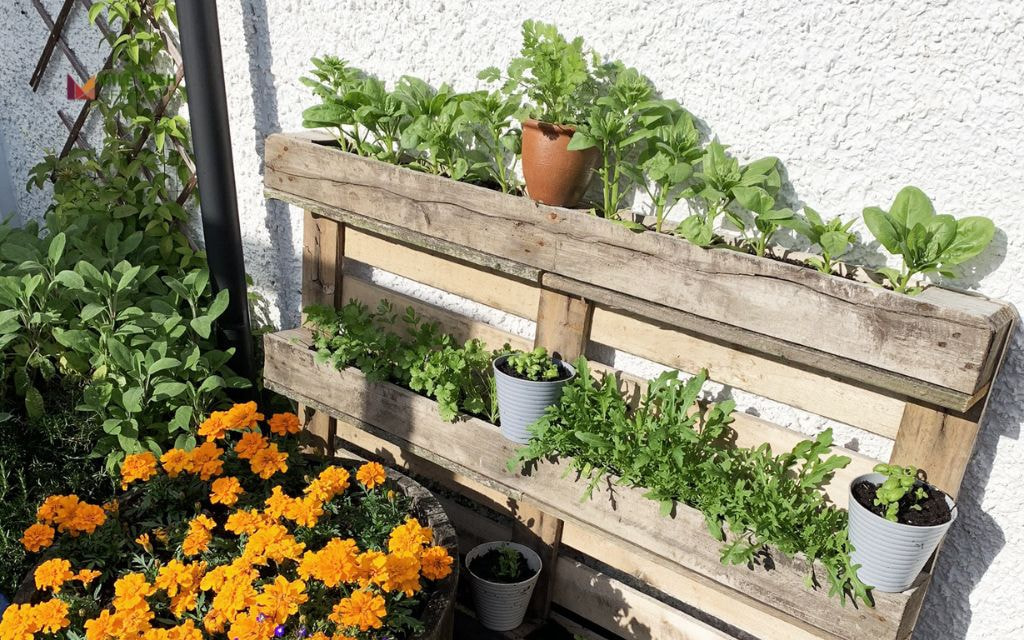
Kids’ Butterfly Garden Bed Using Upcycled Materials
Engage children in gardening while creating habitat for Colorado’s native butterflies. Use recycled materials like old tires, broken concrete pieces, or salvaged lumber to build fun, colorful raised beds that spark imagination.
Plant with butterfly favorites like bee balm, coneflower, and native milkweed while incorporating plants with interesting textures kids love to touch.
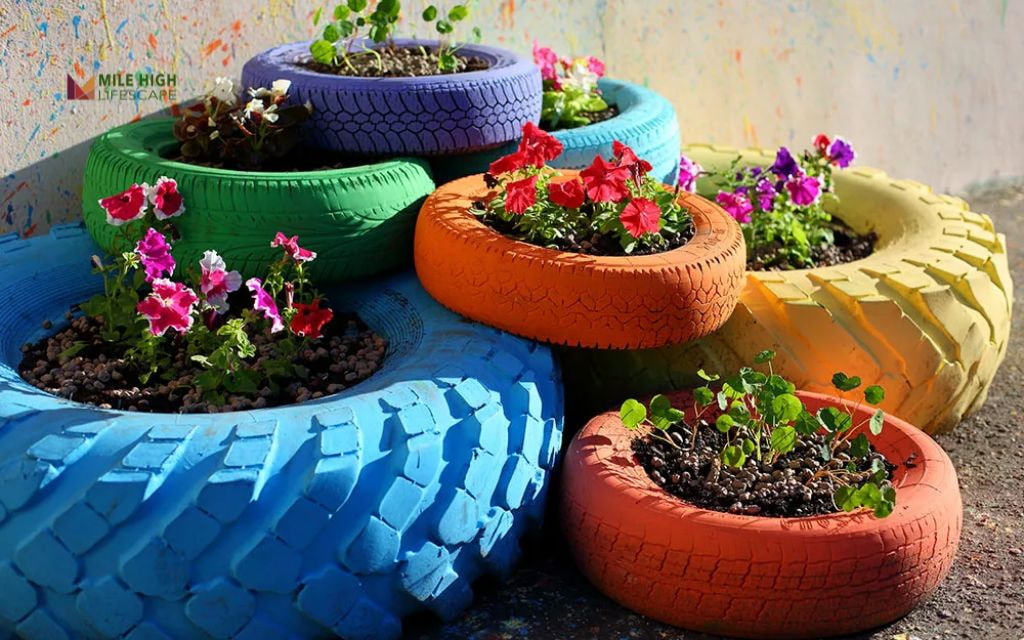
Tips for Building and Maintaining Your Raised Flower Beds
Best Time to Build: Early Spring or Fall
Early spring construction allows soil settling before summer heat stress while fall building provides winter weathering that improves soil structure.
Avoid construction during winter freeze-thaw cycles that damage materials and summer heat that makes outdoor work uncomfortable.
Spring construction enables immediate planting while fall building provides time for soil improvement before the next growing season.
Learn how to design and build raised flower beds in this guide.
Use Untreated Cedar or Stone for Longevity
Cedar lumber naturally resists decay and insects while weathering to attractive silver-gray tones that complement mountain landscapes. Stone construction provides permanent solutions that improve with age. Avoid pressure-treated lumber near edible plants and galvanized steel in areas with acidic soil that accelerates corrosion.
Add Compost Annually to Keep Soil Fertile
Raised beds require regular soil amendment to maintain fertility and structure necessary for continued flower production. Add 2-3 inches of quality compost each spring before planting to replace nutrients consumed during the previous growing season.
Intense sun and low humidity accelerate organic matter decomposition, making annual additions essential. Work compost into the top 6 inches of soil to improve both drainage and nutrient availability.
Use Mulch or Small Rock to Retain Moisture and Suppress Weeds
Moisture conservation becomes critical in Colorado’s arid climate where raised beds dry more quickly than ground-level gardens. Apply 2-3 inches of organic mulch like shredded bark or compost around plants to reduce evaporation and suppress weed growth.
In areas with intense sun exposure, consider decorative gravel or small rocks that reflect heat while providing permanent weed suppression.
Refresh organic mulches annually while rock mulches provide long-term solutions.
Conclusion
Raised flower beds transform Denver gardening by overcoming clay soil challenges while creating stunning displays adapted to Colorado’s unique climate. These elevated gardens provide better drainage, improved soil quality, and easier maintenance than traditional ground-level planting.
For custom flower beds landscaping Denver, contact us at (303) 877-9091 for a consultation.
Our landscaping experts bring 2 decades of Colorado gardening experience to help you create raised bed gardens that thrive in our climate and reflect your personal style and preferences.
Frequently Asked Questions (FAQs)
What do you put in the bottom of a raised flower bed?
You can place landscape fabric or cardboard directly over grass to suppress weeds, then add your soil mix. For drainage-sensitive areas, add 2-3 inches of gravel before soil. In Denver’s clay soil conditions, the raised bed itself provides adequate drainage improvement without additional materials.
What flowers grow best in a raised bed?
Most flowers perform better in raised beds than ground-level gardens, especially in Denver’s clay soil. Native perennials like penstemon, blanketflower, and black-eyed Susan thrive in raised bed conditions. Annuals such as marigolds, zinnias, and petunias also flourish with the improved drainage and soil quality raised beds provide.
What is the cheapest way to make raised flower beds?
Reclaimed materials offer the most budget-friendly approach to raised bed construction. Shipping pallets, concrete blocks, or repurposed lumber create functional beds at minimal cost. For extremely tight budgets, straw bales provide temporary raised bed solutions for annual flowers while gradually decomposing to improve soil quality.
How deep do raised flower beds need to be?
No, most flowers don’t require extremely deep beds. Annual flowers thrive in 6-8 inch depths while perennials prefer 10-12 inches for optimal root development. Deep-rooted natives like penstemon benefit from 12-16 inch depths. Shallow-rooted plants such as sedums flourish in beds as shallow as 6 inches.
What not to put in a raised garden bed?
Avoid pressure-treated lumber around edible plants due to chemical concerns. Don’t use fine sand which creates concrete-like conditions when mixed with Denver’s clay soil. Avoid fresh manure that can burn plants or introduce harmful bacteria. Skip landscape timbers treated with creosote and never use tires for edible plants due to chemical leaching concerns
